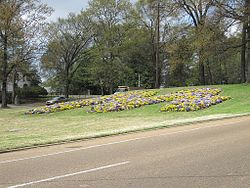Memphis Parkway System
|
Memphis Park and Parkway System
|
|

The Memphis "M" is located on the median of East Parkway at Madison Avenue. Historically, this area was the location of the Sunken Garden in the 1930s.
|
|
| Location | Memphis, Tennessee |
|---|---|
| Coordinates | 35°8′9″N 89°59′0″W / 35.13583°N 89.98333°WCoordinates: 35°8′9″N 89°59′0″W / 35.13583°N 89.98333°W |
| Built | 1903 |
| NRHP Reference # | 89000520 |
| Added to NRHP | July 3, 1989 |
The Memphis Parkway System, locally known as the Parkway System, The Parkways, or simply by their individual names is a system of parkways that formed the original outer beltway around Memphis, Tennessee. They consist of South Parkway, East Parkway, and North Parkway. Designed by George Kessler, the Parkway System connects Martin Luther King Jr. Riverside Park with Overton Park. The system was put on the National Register of Historic Places on July 3, 1989.
In response to the yellow fever epidemic and in an attempt to revitalize Memphis, the city's leaders decided to improve the city's infrastructure, including improving sewer systems, creating public utilities, and creating a system of parks connected by a system of boulevards. Starting in 1897, several areas of land were annexed into the city, along with the areas that now comprise the parks mentioned above. These lands were purchased in 1901. In that same year, the city selected George Kessler to lay out this new plan. Planning and construction of the Lea's Woods tract of land (now known as Overton Park) was started in 1902 and completed in the same year. The development and construction of Wilderberger Farm (now known as Martin Luther King Jr. Riverside Park) started in the same year, but finished a year later in 1903.
The development and construction of what is now known as the Parkway System started in 1904. The project had been delayed due to a lawsuit stating the government was using its power of eminent domain incorrectly, but the Tennessee Supreme Court found in favor of the city. Instead of a winding system of meandering parkways, Kessler decided to create a rectangular border around the city of Memphis using some existing streets. South Parkway and East Parkway (originally Trezevant Street) were constructed first. North Parkway was originally known as Summer Avenue (the name still carried by the route as it continues east from the intersection of North and East Parkways). North Parkway was also known as Speedway. Kessler originally designed parts of the Parkway System to be straight portions of tree-lined avenues where car and carriage owners could race against each other. However, the city of Memphis ended this practice in 1910 and imposed a speed limit on the entire system. Today, the road's racing past can still be seen in the name of the Speedway Terrace Historical District along North Parkway near Watkins Street.
The entire parkway system was completed in 1906. After its completion, residential development along its route increased. Many cities in Tennessee used Memphis' park and parkway system as a model for their own urban planning. The Parkway System roughly marked the city's boundaries for many years to come and is still an important corridor in the city of Memphis.
...
Wikipedia
